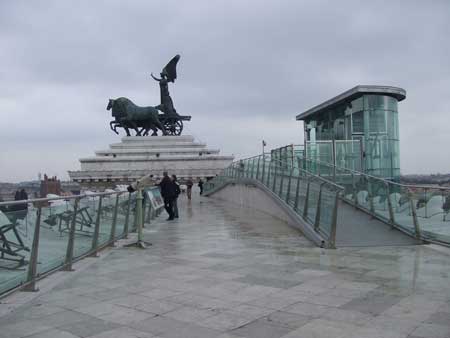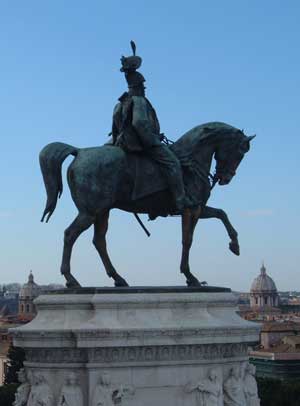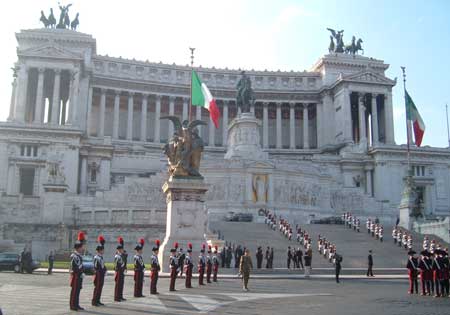The Vittoriano is the huge white monument which mars most panoramic views of Rome. However, from its terraces you can enjoy the best views over the city – not least because the monument itself no longer intrudes on the skyline.
Romans don’t much admire the Vittoriano; they refer to it as ‘the wedding cake’. But this vast monument is still an important focal point for their town. It was built between 1885 and 1911 to celebrate the uniting of Italy as a nation, and dedicated to the first King of all Italy, Vittorio Emanuele II. Of course, the monarchy only lasted another thirty years after the completion of the Vittoriano, and most Italians would still scoff at the idea of unity, but the monument remains and is still important for those Italians with thoughts of nationhood. Guarded by soldiers, a flame burns on the front terrace of the monument to mark the grave of an unknown soldier; this is the Altar of the Fatherland, the Altare della Patria. Tourists from other parts of Italy make a beeline for the Vittoriano, but it is worth visiting even if you feel no such patriotic awe or affection. From the upper levels there are great views over Rome, and in 2007 a glass lift (elevator) was installed to take paying visitors up to the very top of the monument, on the roof between the two crowning statuary groups. It’s a good place to begin your sightseeing in Rome, since it gives you an unmatchable overview of the city and its geography.

When this monstrosity was built, it occupied and destroyed part of the Capitol, the central and sacred hill of Ancient Rome. The hill still rises behind it, and the Vittoriano’s terraces can generally be reached via the Campidoglio (the modern Capitol), and sometimes, when the church is open, from the church of Santa Maria in Aracoeli. Some surviving Roman ruins can still be seen at the base of the Vittoriano. The building dominates Piazza Venezia, a busy traffic-filled square, where you may see the sight of a white-gloved policemen on a podium directing traffic. The square usually features grassy lawns and flowerbeds in the middle but at the time of writing there are excavations taking place. The long, straight Via del Corso, now Rome’s busiest shopping street, runs from Piazza Venezia, directly opposite the Vittoriano, all the way to Piazza del Popolo.

The massive gilt bronze equestrian statue is of Vittorio Emanuele II. When the casting of the statue was completed, a celebratory dinner was held in the horse’s stomach. The other statues and decorations ornamenting the monument all have allegorical significance: the statues around the base of the equestrian statue, for example, represent fourteen historically-important cities of Italy. The two quadrigae on top symbolise Liberty and Unity. The bright white marble used is from Brescia in the north of Italy.
Inside the monument are many exhibition rooms, some with permanent displays and others used for temporary exhibitions. There is a Museo del Risorgimento, dedicated to the uniting of Italy, and exhibition halls where major exhibitions are mounted.
A few entrances lead in and out of the structure; it’s a bit of a maze, particularly since parts of the terraces are often closed off for restorations. Generally you can enter through a gate at the front and climb the steps upwards as far as the colonnaded terrace behind the equestrian statue. Towards the top, and around the back of the main monument – to the left as you ascend – is a terrace cafe. Close to this, and directly behind the grand colonnaded part of the Vittoriano, is a narrow passage between the monument and the Church of Santa Maria in Aracoeli. This is where you can take the glass lift (ascensore in Italian) which ascends to the highest panoramic terrace. Such additions to Italy’s monuments are usually upsetting to see, but the Vittoriano is so bulky and ugly, and recent, that the addition of this lift at the back hardly seems a big deal. It costs 7 euros but it is a worthwhile expense: the view of Rome is wonderful. There is an information leaflet in English and also signs which help you to spot Rome’s principal landmarks. There are some free powerful telescopes, but on a busy day it would be a good idea to bring your own binoculars if you are organised enough to travel with a pair. Once the lift has taken you up to the terrace you are free to potter around admiring the view over the Forum, over the Centro Storico and out to the suburbs and – on a clear day – to the hills beyond.
The main part of the monument, accessed from the gate on Piazza Venezia, is open daily from 9:30am until 4:30pm (later in summer). The top panoramic terrace and lift (‘Quadrigas Terrace’) are open later, until 6:30pm Monday-Thursday and until 7:30pm Friday-Sunday, and are best reached from an entrance in the Piazza Ara Coeli side of the Vittoriano, or via the staircase from Piazza del Campidoglio. The glass lift does not descend to ground level, so if you can’t manage the steps, head inside the Vittoriano and use the internal lifts to reach the lower terrace. The principal entrance to the Museo del Risorgimento is from Via di San Pietro in Carcere, around the back of the monument (to the left). Just beyond it is the entrance to the major temporary exhibition space. Most of the parts of the complex only allow admission until 45 minutes prior to closing time.
The monument is attended by wardens as well as the military guards. They will blow loud whistles if you do anything untoward, such as sitting down, leaning over parapets or engaging in ‘disrespectful’ behaviour. Don’t even think of picnicking up here – but you can visit the terrace cafe or enjoy a sit-down in a little area with benches and trees nearby, just off Piazza del Campidoglio.
Around the Vittoriano
Visiting the Vittoriano fits in well with an itinerary around the Roman Forum and the Campidoglio, including a visit to the large and excellent Capitoline Museums. As well as being within walking distance of almost all the sights of Rome, Piazza Venezia is one of the hubs of Rome’s bus network.
On this site
External links
